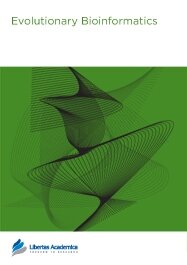

Publication Date: 31 Jul 2011
Type: Original Research
Journal: Evolutionary Bioinformatics
doi: 10.4137/EBO.S6861

We have developed a semi-automatic methodology to reconstruct the phylogenetic species tree in Protozoa, integrating different phylogenetic algorithms and programs, and demonstrating the utility of a supermatrix approach to construct phylogenomics-based trees using 31 universal orthologs (UO). The species tree obtained was formed by three major clades that were related to three groups of data: i) Species containing at least 80% of UO (25/31) in the concatenated multiple alignment or supermatrix, this clade was called C1, ii) Species containing between 50%–79% (15–24/31) of UO called C2, and iii) Species containing less than 50% (1–14/31) of UO called C3. C1 was composed by only protozoan species, C2 was composed by species related to Protozoa, and C3 was composed by some species of C1 (Protozoa) and C2 (related to Protozoa). Our phylogenomics-based methodology using a supermatrix approach proved to be reliable with protozoan genome data and using at least 25 UO, suggesting that (a) the more UO used the better, (b) using the entire UO sequence or just a conserved block of it for the supermatrix produced similar phylogenomic trees.
PDF (1.08 MB PDF FORMAT)
RIS citation (ENDNOTE, REFERENCE MANAGER, PROCITE, REFWORKS)
Supplementary Files 1 (2.30 MB ZIP FORMAT)
BibTex citation (BIBDESK, LATEX)
XML
PMC HTML
Publishing in Air, Soil and Water and Water Research was the best experience I have had so far in an academic context. The review process was fair, quick and efficient. I congratulate the team at Libertas Academica for a very well managed journal.Magnus Karlsson (IVL Swedish Environmental Research Institute, Stockholm, Sweden) What Your Colleagues Say
Copyright © 2012 Libertas Academica Ltd (except open access articles and accompanying metadata and supplementary files.)
FacebookGoogle+Twitter
PinterestTumblrYouTube